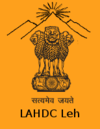Ladakh Autonomous Hill Development Council, Leh
| Ladakh Autonomous Hill Development Council, Leh | ||
|---|---|---|
| territorial council | ||
| ||
 Location in India | ||
| Country |
| |
| State | Jammu and Kashmir | |
| Established | 14 Mar 2012 | |
| Covering Territory | Leh | |
| Former seat | Leh | |
| Government | ||
| • Chief executive | Dr. Sonam Dawa Lonpo | |
| Area | ||
| • Total | 82,665 km2 (31,917 sq mi) | |
| Population (2011) | ||
| • Total | 147,104 | |
| • Density | 1.8/km2 (4.6/sq mi) | |
| Languages | ||
| • Official | English, Ladakhi, urdu | |
| Time zone | IST (UTC+5:30) | |
| Website | leh.nic.in | |
The Ladakh Autonomous Hill Development Council, Leh (LAHDC) is an Autonomous Hill Council that administers the Leh District of Jammu and Kashmir, India.[1]
History
The council was created under the Ladakh Autonomous Hill Development Council Act 1995, following demands of Ladakhi people to make Leh District a new Indian Union Territory because of its religious and cultural differences with the rest of Jammu and Kashmir. In October 1993, the Indian Union Government and the Jammu and Kashmir State Government agreed to grant Ladakh the status of Autonomous Hill Council. The council came into being with the holding of elections on August 28, 1995. The inaugural meeting of the council was held at Leh on September 3, 1995. An Autonomous Hill Council has also been established in neighbouring Kargil District www.kargil.nic.in. In 2003, as part of its "healing touch policy", the J&K government announced popular elections for the Autonomous Hill Development Council in Kargil, which was meant to strengthen participatory forms of development, governance and democratic state-building in the war-ravaged district.[2]
Logo
The council recently changed its logo to three head Sarnath lions of the Ashoka capital replacing the previous Buddhist eight arm wheel.
Structure
The council is composed of 30 Councillors of which 26 are directly elected and 4 are nominated members.[3]
The executive arm of the council consists of an executive committee composed of a Chief Executive Councillor, currently Dr Sonam Dawa Lonpo, and four other Executive Councillors.[4]
Vision 2025
On May 8, 2013 mutual collaboration for sustainable development in Ladakh in the tune with Ladakh Vision Document 2025” was jointly organised by LAHDC and NABARD at Sindhu Sanskriti Kendra in Leh. The workshop-cum-discussion session was inaugurated by the then Chief Executive Councillor of Ladakh Autonomous Hill Development Council, Rigzin Spalbar by lighting up the lamp in the presence of Executive Councillors. In his introductory speech, Rigzin Spalbar talked about Ladakh Vision Document 2025 which was prepared in 2005 by a committee of 20 members headed by Sonam Dawa, former Chief Engineer and Advisor of Ladakh Ecological Development Group. These members belonging to different fields of expertise had put a great effort in the conceptualisation of the Vision Document. CEC took the opportunity to felicitate them at the function with a traditional scarf and a memento.
- See more at: http://www.reachladakh.com/lahdc-and-nabard-joined-hands-to-work-towards-vision-2025/1585.html#sthash.3IccAYUm.dpuf
Executive Councillors
Dr. Sonam Dawa Lonpo Chief Executive Councillor
Dr. Dorjay Motup (Executive Councillor)
Mr. Tsering Wangdus (Executive Councillor)
Mr. Mumtaz Hussain (Executive Councillor)
Mr. Tsering Sangdup (Executive Councillor)
Mr. Prasanna Ramaswamy IAS (Chief Executive Officer / DC)
All Councillors
BJP - 18
INC - 05
NC - 02
IND - 01
Yet to be nominated - 04
See also
- Ladakh Marathon, a marathon organised by LAHDC
References
- ↑ http://leh.nic.in/lahdc.htm
- ↑ Bhan, Mona. The Hill Council and the Healing Touch policy. Routledge Contemporary South Asia Series. p. 63.
- ↑ http://leh.nic.in/adm.htm
- ↑ http://leh.nic.in/who's_who_with_tele_nos.htm
